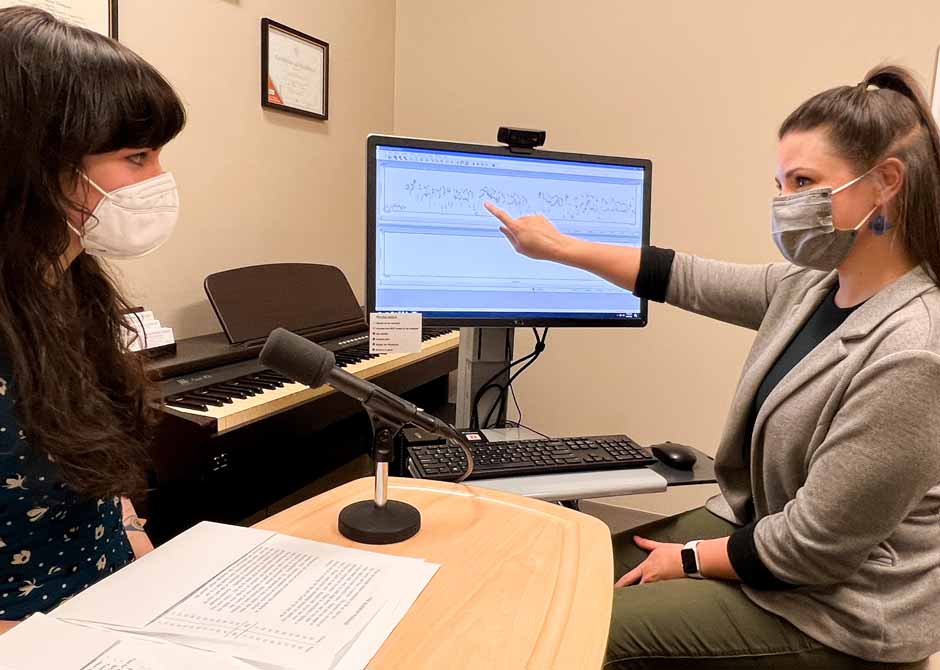 When nationally renowned touring performers or stage-commanding opera singers have pain while singing or hoarseness in their voice, it can be catastrophic to not only their livelihood but also their ability to enjoy life.
When nationally renowned touring performers or stage-commanding opera singers have pain while singing or hoarseness in their voice, it can be catastrophic to not only their livelihood but also their ability to enjoy life.
That’s why many of them turn to the dedicated Voice Center at The Ohio State University Wexner Medical Center in Columbus, Ohio, for help. As a destination for voice disorder treatment, we have experts specially trained in healing voice problems with a variety of methods beyond surgery.
Our experts include five fellowship-trained laryngologists — the most in the Midwest region — as well as speech pathologists who are classically trained opera singers and nurses who work solely with people struggling with voice problems.
We specialize in paradoxical vocal cord motion disorder (PVCMD) — a vocal cord abnormality that mimics asthma — and see more people with this condition than most other hospitals in the country. While those who sing and use their voice in a professional setting can be more at risk for these issues, we recognize how important everyone’s voice is, whether you’re a teacher, restaurant server or CEO, and will work to restore your voice.
What is dysphonia?
Dysphonia is the medical term for a group of disorders that affect your voice. Excessive talking, straining and constantly clearing your throat can lead to these voice disorders. Other causes of dysphonia include:
- Acid reflux
- Vocal cord paralysis from disease
- Growth due to viruses or cancer
- Vocal cord polyps or lesions
- Infections
- Hormones
- Paradoxical vocal cord motion disorder
- Laryngitis or pharyngitis
When you experience dysphonia, your voice changes and, in some cases, might be unrecognizable. Other signs and symptoms of a voice disorder include:
- Your voice becomes hoarse or raspy.
- Your voice suddenly sounds deeper.
- Your throat often feels raw, achy or strained.
- You struggle to talk without breaks or at all.
- You lose the ability to hit some high notes while singing.
 Types of dysphonia
Types of dysphonia
There are various conditions that fall under the umbrella of dysphonia. They affect different parts of your larynx (voice box), vocal cords or other throat structures. A few common types of dysphonia are:
Hoarseness
Hoarseness occurs when the vocal cords become inflamed, swollen or irregular. The swelling that results is what causes hoarseness, a rough and raspy sound to your voice. Cold and sinus infection are usually to blame for hoarseness and it takes about two weeks for hoarseness to get better.
Spasmodic dysphonia
When the condition called spasmodic dysphonia exists, muscles that control the vocal cords spasm due to overactive signals from the brain. Botulinum toxin is injected into the muscles to block the signals, which reduces the intensity and amount of spasms.
Functional dysphonia
This happens when your voice quality is impacted by something other than anatomical, neurological or other organic difficulty. It’s typically the result of overuse of certain muscles in the throat and larynx.
Muscle tension dysphonia
Your voice can change because of too much muscle tension in and surrounding your larynx. This can include the vocal folds, which are muscles in the voice box.
Additional voice disorders
There are many other conditions that impact the way we talk and communicate. A sampling of the ones we treat here at the Ohio State Wexner Medical Center include:
Paradoxical vocal cord motion disorder (PVCMD)
Paradoxical vocal cord motion disorder (PVCMD) is when your vocal cords have episodes of closing instead of opening as you breathe. This condition makes getting air in and out of your lungs difficult, and it mimics asthma.
Laryngitis
Inflammation of the voice box (larynx) accompanied by hoarseness or loss of voice is laryngitis. Viral infection from a cold or flu is usually to blame for laryngitis, but it can also be caused by allergies, injury or pneumonia.
Laryngocele
When air sacs in your voice box bulge out, they can obstruct your airway or create hoarseness. These bulges are called laryngoceles and while they’re usually benign, they can cause discomfort or annoyance and should they become infected, they may need to be removed.
Laryngopharyngeal reflux
When the muscle at the top of the esophagus — called the upper esophageal sphincter — doesn’t close properly, stomach acids can bubble up all the way to the throat and even nasal cavities. That’s when laryngopharyngeal reflux occurs.
Vocal cord cancer
The larynx is a part of the throat, between the base of the tongue and the trachea. The larynx contains the vocal cords. Using tobacco and excessively using alcohol are the greatest risk factors for laryngeal cancer, which affects more than 12,000 people in the United States each year.
Vocal cord lesions
Vocal cord lesions are noncancerous (benign) growths inside or outside of the vocal cords. They are one of the most common causes of voice problems and can be cysts, nodules or polyps. Lesions that are a result of trauma and located opposite existing vocal cord lesions are called reactive.
Vocal cord paralysis
When nerve impulses in your voice box (larynx) are interrupted, your vocal cord muscle can become paralyzed. When this happens, speaking and breathing can both be affected. Damage to nerves during surgery, infection, neurological disorder and cancer can be the cause of vocal cord paralysis.
Voice disorders
What does it mean if my vocal cords aren't working properly?
Vocal fold paralysis is when one or more of the vocal cords aren't working properly. Dr. deSilva explains the causes of this common condition and treatment options offered at Ohio State.
What vocal cord issues should I be concerned about as someone who smokes?
Smoking can have lasting effects on the vocal cords. Dr. Matrka explains some of these common vocal issues and Ohio State's expertise in treating them.
Dysphonia and voice disorder treatments
You shouldn’t have to live with chronic hoarseness or other persistent voice changes, nor should surgery be your only treatment option. As an academic health system, the Ohio State Wexner Medical Center participates in national, multi-institutional clinical research studies and are on the cutting edge of discovery in the voice and swallowing field, so we have the latest treatments available.
While some voice disorders will get better with simply time, rest and relaxation, others can be much more complicated and nagging. We have a collaborative team of specialists ranging from therapists to advanced practice providers to surgeons and other ear, nose and throat doctors to provide care in these instances. Some examples of dysphonia treatment include:
- Voice, swallowing or laryngeal control therapy – to learn vocal exercises, breathing techniques and relaxation methods
- Medications – to help manage acid reflux or hormonal changes
- Vocal cord injections – to treat spasms with botulin toxin or other fillers
- KTP laser treatments – to destroy unwanted tissues or masses
- Direct microlaryngoscopy – to remove vocal cord lesions and other growths
- Surgery – to remove masses or restore voice function
Additional Information
How would you like to schedule?
Don’t have MyChart? Create an account


